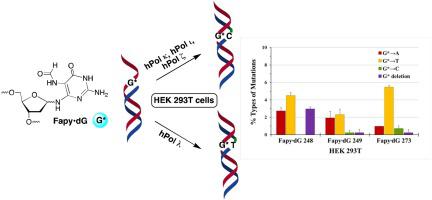DNA Repair ( IF 3.0 ) Pub Date : 2021-08-16 , DOI: 10.1016/j.dnarep.2021.103213 Jan Henric T Bacurio 1 , Haozhe Yang 2 , Spandana Naldiga 1 , Brent V Powell 1 , Benjamin J Ryan 3 , Bret D Freudenthal 3 , Marc M Greenberg 2 , Ashis K Basu 1

|
Fapy•dG and 8-OxodGuo are formed in DNA from a common N7-dG radical intermediate by reaction with hydroxyl radical. Although cellular levels of Fapy•dG are often greater, its effects on replication are less well understood than those of 8-OxodGuo. In this study plasmid DNA containing Fapy•dG in three mutational hotspots of human cancers, codons 248, 249, and 273 of the p53 tumor suppressor gene, was replicated in HEK 293T cells. TLS efficiencies for the Fapy•dG containing plasmids varied from 72 to 89%, and were further reduced in polymerase-deficient cells. The mutation frequency (MF) of Fapy•dG ranged from 7.3 to 11.6%, with G→T and G→A as major mutations in codons 248 and 249 compared to primarily G→T in codon 273. Increased MF in hPol ι-, hPol κ-, and hPol ζ-deficient cells suggested that these polymerases more frequently insert the correct nucleotide dC opposite Fapy•dG, whereas decreased G→A in codons 248 and 249 and reduction of all mutations in codon 273 in hPol λ-deficient cells indicated hPol λ’s involvement in Fapy•dG mutagenesis. In vitro kinetic analysis using isolated translesion synthesis polymerases and hPol λ incompletely corroborated the mutagenesis experiments, indicating codependence on other proteins in the cellular milieu. In conclusion, Fapy•dG mutagenesis is dependent on the DNA sequence context, but its bypass by the TLS polymerases is largely error-free.
中文翻译:

Fapy•dG复制在人细胞p53基因三个突变热点序列中的序列背景效应
Fapy•dG 和 8-OxodGuo 是通过与羟基自由基反应从常见的 N7-dG 自由基中间体在 DNA 中形成的。尽管 Fapy•dG 的细胞水平通常更高,但它对复制的影响不如 8-OxodGuo 的那些那么好。在这项研究中,在人类癌症的三个突变热点、 p53的密码子 248、249 和 273 中包含 Fapy•dG 的质粒 DNA肿瘤抑制基因,在 HEK 293T 细胞中复制。含有 Fapy•dG 的质粒的 TLS 效率从 72% 到 89% 不等,并且在聚合酶缺陷细胞中进一步降低。Fapy•dG 的突变频率 (MF) 在 7.3 到 11.6% 之间,G→T 和 G→A 是密码子 248 和 249 中的主要突变,而密码子 273 中主要是 G→T。hPol ι- 中的 MF 增加, hPol κ-和 hPol ζ 缺陷细胞表明,这些聚合酶更频繁地插入与 Fapy•dG 相对的正确核苷酸 dC,而密码子 248 和 249 中的 G→A 减少以及 hPol λ 缺陷细胞中密码子 273 中所有突变的减少表明 hPol λ 参与 Fapy•dG 诱变。体外使用分离的跨损伤合成聚合酶和 hPol λ 的动力学分析不完全证实了诱变实验,表明细胞环境中对其他蛋白质的相互依赖性。总之,Fapy•dG 诱变依赖于 DNA 序列背景,但它被 TLS 聚合酶绕过基本上没有错误。











































 京公网安备 11010802027423号
京公网安备 11010802027423号